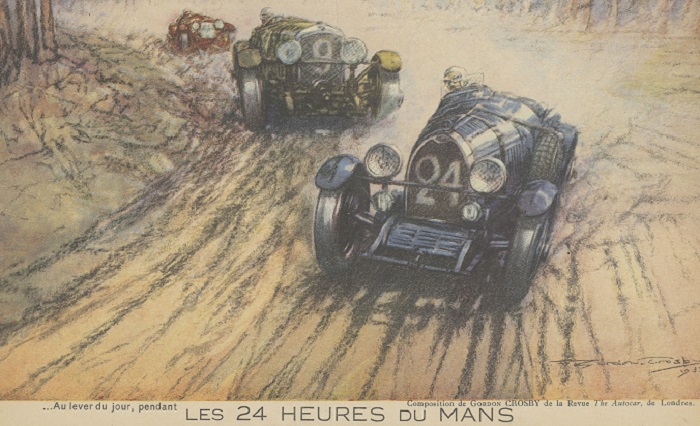The 24 Hours of Le Mans, Technical Innovations Kick-off (3 / 6)
Other than just a great sports event, The 24 Hours of Le Mans have also been a laboratory of development and innovation for automotive engineering. The results would eventually be seen - sooner or later - on every day’s road cars. Let’s discover together some of these innovations.
Revue des usagers de la route, 1933, Bibliothèque municipale du Mans
Organized as the first 24 hours endurance race, the car manufacturers have shown an interest for the event from its very first editions. They have seen an opportunity to promote their brands thanks to the proven performance and the reliability of their cars. It has also been the chance to engineer, develop, test and validate in extreme conditions the technologies, parts and accessories in order to transfer them on to commun cars.
Being one of the first races to be running partly at night, the way to manage the lighting and the development of the headlights has been an important point for the teams.
Le Mans, Endurance Race, overall view by night in front of the grand stand, 13 June 1926 Agence Rol
Lorraine-Dietrich (nr 4, 5 et 6) was the brand to finish in the top three overall of the 1926’s edition. Their originality: the cars are all equipped with a third - anti fog headlight. This detail contributed to the result, as the fog at some moments of the race represented a real issue for the competitors.
Le Mans, Endurance Race, Stalter and Brisson on Lorraine-Dietrich, 13 June 1926, Agence Rol
Le Mans, Endurance Race, André Rossignol on Lorraine-Dietrich, 13 June 1926, Agence Rol
Later on, in 1962, a 330 TRI/LM Ferrari was using for the first time, a halogen headlight based on the iodine steam. This technology was used later on by all the racecars of that period.Recently, the 2011’s winning prototypes were equipped with LED technology headlights and starting from 2014 the laser technology prevails for lightning.
At the start of the 1925th edition the spectators are surprised to discover a different and original bodywork design on the Chenard & Walker Tank (race number 49). It is the first car to race in Le Mans with an aerodynamic body shape. This car performs better thanks to an improved air penetration coefficient. The aerodynamic work will have a big contribution on the road cars, especially performance sports cars and would improve the fuel consumption.
Le Mans, Endurance Race, Sénéchal - Locqueneux son Chenard-Walcker [n°49], de Courcelles - Rossignol [n°5], 20 June 1925, Agence Rol
In June 1927 the Tracta is the first ever front wheel driven racecar to take part at the Le Mans 24 Hours race. The engine power transmitted to the front wheels is using an invention: the hemokinetic joints. Driven by his inventor himself, the French engineer Jean Albert Grégoire, the Tracta will finish the race at the seventh place overall. Owner of a garage workshop near Versailles, Grégoire will be joined and helped in his project by the French entrepreneur and amateur driver Pierre Fenaille. This revolutionary invention would later be adopted by André Citroen on his Citroen Traction, a very popular and best seller French car (manufactured between 1934 and 1957).
As the world is recovering after the war and the Le Mans 24 Hours race would start again in 1948, a double World Premiere was brought in for the 1951st edition of the race by the Italian team Scuderia Abrosiana. Their Lancia Aurelia B20 GT is equipped with the brand new V6 engine and is using the Michelin X tyre (radial tyre carcass). The car will finish the race at the twelfth place overall, and first of its class. It covered 235 laps (more than 3100 km) and ended the race with the same set of tires as at the start, which was used at half of its potential only.
The contribution and advantages of the radial tires in terms of handling, braking, confort or safety are no longer to demonstrate. In fact, the radial tire technology was patented by Michelin in 1946 and is still applied today to all the cars, trucks or planes.
After multiple progresses and improvements made to the braking systems, it is in the 1953 edition of Le Mans that a revolutionary technology is introduced by Jaguar with the Type C model: the brake discs. As a result, the braking performances being exceptional and improving dramatically security, this technology will soon became a standard on both race and road cars.
Over the years the injection engine, rotary engine, the modern diesel engine, the hybrid systems have equipped the racecars that have written and will continue to write through their ingenuity and novelty the legends of The 24 Hours of Le Mans.
 Cultural Olympiad is a multidisciplinary artistic and cultural program which runs from the end of the previous Games to the end of the Paralympic Games.
Cultural Olympiad is a multidisciplinary artistic and cultural program which runs from the end of the previous Games to the end of the Paralympic Games.
The Gallica series « Centenary of The 24 Hours of Le Mans » is part of the official Paris 2024 programming.








